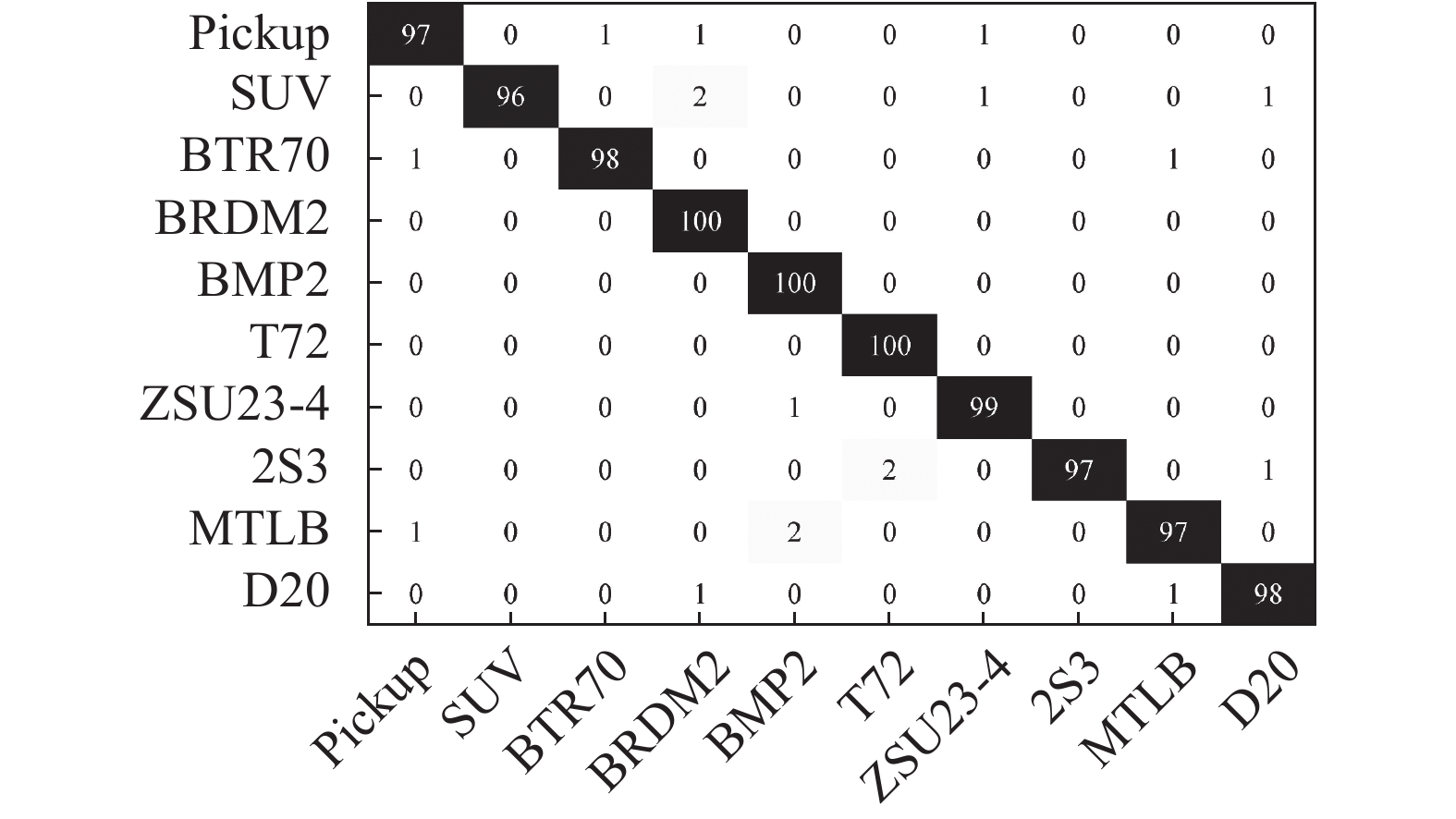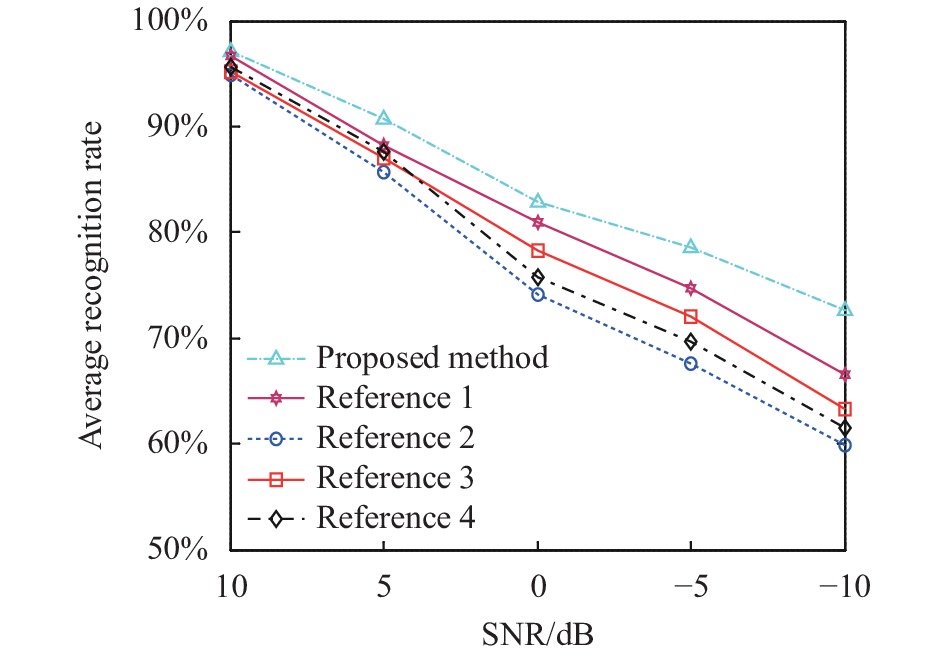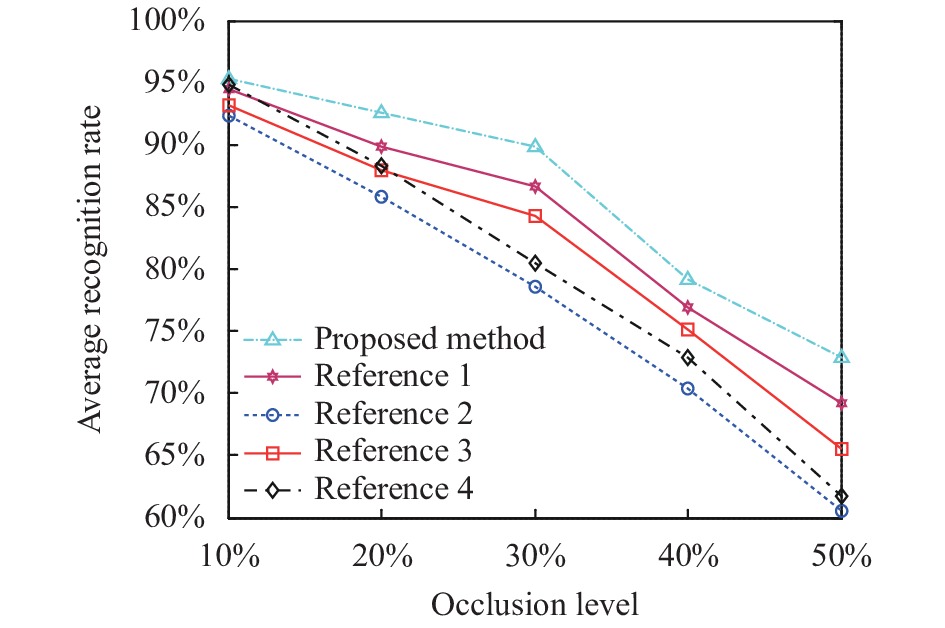-
红外图像反映观测场景的热效应,具有昼夜工作的能力,是对可见光成像手段的有力补充[1]。随着红外传感器的不断成熟,其高分辨图像可为目标识别、探测制导等提供有力工具[2-6]。红外目标分类旨在对包含未知目标的红外图像切片进行类别判断,可归结为典型的有监督分类问题。当前,针对红外目标分类问题,主流方法可区分为特征主导和分类器主导。前者主要开展红外图像特征提取算法研究,获得区分性更强的特征类别,典型的包括目标几何特征、局部纹理特征、灰度变换特征等[7-10]。后者试图通过选用高性能分类器提高分类精度,具有代表性的有包括支持向量机(Support vector machine,SVM)[11]、稀疏表示分类(Sparse representation-based classification,SRC)[12]等。当前,深度学习模型成为图像解译领域的流行工具[13],也在红外目标分类中得到的应用和验证[14-15]。
文中将单演信号引入红外图像特征提取,并通过针对性选用分类策略用于多类目标的红外图像分类。单演信号作为解析信号的二维扩展,可用于图像的分解处理,目前在人脸识别和SAR目标识别领域得到了应用和验证[16-18]。对于红外目标图像,经过单演信号分解后可表征为幅度、相位和方位3个不同成分的特征矢量。三者从不同角度描述了原始图像中目标的特性,可层次化反应目标的图像、频谱域特征,具有良好的互补性。同时,三者来源于同一幅图像的相同目标,故又有一定的内在关联性。在分类阶段,文中选用多任务联合稀疏表示模型对3类单演信号特征进行统一表征。联合稀疏表示模型同步考察多个具有关联性的稀疏表示问题[18-21]。经证明,其求解结果优于这些稀疏表示问题独立获得的结果。为此,文中将其用于红外图像单演信号特征的重构,根据不同类别对于当前图像的重构误差进行类别决策。所提方法可有效结合单演信号和联合稀疏表示模型在特征提取和分类决策方面的双重优势,从而提高最终的分类可靠性。实验在中波红外图像数据集(MWIR)[15]上进行,对10类典型车辆目标进行分类。实验场景包含了原始样本、噪声样本和遮挡样本,通过与4类现有对比方法进行比较分析,结果表明了文中所提方法的有效性和稳健性。
-
单演信号是传统一维解析信号的二维扩展,主要用于特性的时频域分析,获得更深层次的特征[16-18]。现阶段,单演信号在人脸识别、遥感图像目标识别等方向都进行了运用和验证。对于一幅输入图像
$f({\textit{z}})$ ,其中${\textit{z}} = (x,y) \in {{{R}}^2}$ 代表二维像素坐标。采用Riesz变换进行处理,可表示为:在频域,Riesz变换表达式为:
式中:
$\omega {\rm{ = (}}u,v{\rm{)}} \in {{{R}}^2}$ 。输入图像
$f({\textit{z}})$ 的Riesz变换计算可表示为:通常,在单演信号的分解过程中利用带通型Log-Gabor滤波器得到不同尺度的分解结果,滤波器的频率响应可表示为:
式中:
${w_0}$ 为滤波器中心频率;$\sigma $ 代表尺度。由此,滤波后的单演信号表示为:式中:
${f_{\lg }}({\textit{z}}){\rm{ = }}f({\textit{z}}) * {F^{ - 1}}(G(\omega ))$ ,${F^{ - 1}}$ 表示二维傅里叶逆变换。根据上述结果,通过单演信号分解可针对性定义3类分解特征,即局部幅值
$A({\textit{z}})$ 、相位$\varphi ({\textit{z}})$ 、方向$\theta ({\textit{z}})$ ,分别表示为:上述3类特征可从不同方面描述被分解图像的特性。其中,像素幅度分布规律主要由幅度分量体现;相位和方向分量主要描述目标的频域以及局部特性。为此,从信息的完整度来说,单演信号分解结果相比于原始图像具有优势。现有研究表明,基于3类单演信号特征的联合有助于提高目标分类性能。为此,文中按照参考文献[17]中的思路设置单演信号分解参数,定义3个不同尺度的Log-Gabor滤波器,最终得到3个层次,9个分量的单演谱成分。在此基础上,对幅度、相位和方向每一类的3个分量进行矢量化串接,并通过随机投影降维获得对应的3个特征矢量。文中后续的分类算法就是基于这3个特征矢量开展的。
-
联合稀疏表示模型可对若干具有关联性约束的稀疏表示问题进行联合求解。相关研究表明,在多个稀疏表示问题具有相关性时,联合稀疏表示模型的求解结果具有更高的精度和稳健性[18-21]。对于同一红外目标图像分解得到的单演信号特征矢量,它们在反映目标不同方面特性的同时也存在着内在关联性。因此,它们的稀疏表示问题可纳入联合稀疏表示框架进行求解。假设
$y$ 为待分类的红外目标图像,其经过单演信号分解得到幅度、相位和方位3个特征矢量分别记为:${y^{(1)}}{\rm{ }},{y^{(2)}},{\rm{ }}{y^{(3)}}$ 。为在统一框架下求解3类特征的全局稀疏表示系数,定义优化的目标函数如下:式中:
${A^{(k)}}$ 为对应第k(k=1,2,3)个单演信号特征的全局字典;${\alpha ^{(k)}}$ 为相应的稀疏系数矢量;$\;\beta = \left[ {{\alpha ^{(1)}}{\rm{ }}{\alpha ^{(2)}}{\rm{ }}{\alpha ^{(3)}}} \right]$ 表示系数矩阵。与传统稀疏表示模型相比,公式(7)仅仅在形式了统一了3个特征的表征问题,但并没有利用它们之间的关联性。联合稀疏表示模型则对3类特征的稀疏表示系数进行了适当约束,获得更新后的优化目标函数如下:
式中:采用
${\ell _{\rm{1}}}/{\ell _2}$ 范数对系数矩阵$\;\beta $ 进行约束,使得它们趋近于相近的模式(非零元素)分布;${{\lambda }}$ 为大于零的常数。根据现有研究成果,可采用基于贪婪机制的同时正交匹配追踪(Simultaneous orthogonal matching pursuit,SOMP)[18-20]算法或多任务压缩感知(Multi-task compressive sensing,MTCS)[21]算法对公式(8)中的优化问题进行求解。在求解获得稀疏系数矩阵的基础上,可按照公式(9)分布计算不同训练类别对于当前红外目标图像3类单演信号特征的整体重构误差,进而实现类别决策。
式中:
$A_i^{(k)}$ 为第i类中对应第k个单演信号特征的局部字典;$\alpha _i^{(k)}$ 则是与$A_i^{(k)}$ 对应的系数矢量。 -
根据所提方法的原理,构建如图1所示的红外目标分类流程,具体分解为以下关键步骤:

Figure 1. Procedure of infrared image target classification based on joint representation of monogenic features
Step 1:采用单演信号对训练样本进行分解,分别对幅度、相位和方位特征矢量构建全局字典;
Step 2:对测试样本进行单演信号特征提取,获得相应的特征矢量;
Step 3:基于联合稀疏表示模型对测试样本的3类单演信号特征矢量进行表征,求解稀疏系数矩阵;
Step 4:按照类别分别计算对于测试样本单演信号特征的重构误差,根据最小误差原则作出分类决策。
文中具体实施中,为减小算法的时间消耗,选用效率更高的SOMP算法进行联合稀疏表示模型的求解。
-
选用参考文献[15]中的中波红外图像数据(MWIR)对所提方法进行测试。图2给出了该数据集中包含的10类目标的典例图像,既有民用轿车也有军用的坦克、装甲车等。不同目标在工作状态下的红外热效应可从图中直观看出。对于任一类目标,MWIR数据集通过圆周观测的方式获得不同方位角的图像结果。为开展分类实验,选取每一类目标的120幅图像作为训练样本,100幅图像作为测试样本。
为验证所提方法的有效性,将其在相同测试条件下与现有红外识别方法进行对比。4类对比方法的相关信息如表1所示。这4类方法既包括特征主导类别(保留轮廓特征、HOG特征、协方差描述子)也包括分类器主导类别(SVM、核稀疏编码),还包含基于深度学习模型(CNN)的新方法,具有较强的对比意义,可有效反映所提方法的性能。后续测试除在原始样本上开展外,还模拟构建了噪声场景和遮挡场景,进一步评估所提方法的稳健性。
-
实验首先基于原始样本开展,按照文中设置10类目标的测试样本各有100幅。所提方法对各类目标的识别结果展示如图3所示,描述了测试样本被归属为不同类别的样本个数。其中,对角线元素即为正确识别的样本数。定义10类目标的平均识别率为所有正确识别样本占全体测试样本的比例,计算可得所提方法的结果为98.2%,处于较高的水平。表2在相同条件下比较了所提方法和4类对比方法的性能。从分类精度(即平均识别率)来看,所提方法性能最佳。基于CNN的对比方法4仅次于所提方法,表明深度学习模型很好的分类能力。其余3类对比方法尽管可以取得94%以上的平均识别率,但相对所提方法仍有一定差距。从分类效率来看,表2给出的不同方法进行单个测试样本的处理时间表明,所提方法相比直接运用稀疏表示或SVM的两类对比方法效率略低,但整体处于较高的水平。综合考虑分类精度和效率,所提方法对于原始样本的分类能力较强,整体优势较为明显。
Method type Average recognition rate Efficiency/ms Proposed method 98.2 94.8 Reference 1 94.4 146.7 Reference 2 95.1 87.3 Reference 3 95.3 92.4 Reference 4 97.4 113.2 Table 2. Comparison of performance of different methods on orginal test samples
-
图2所示的原始样本获取条件较为理想,目标的完整度和图像的信噪比(Signal-to-noise ratio,SNR)都较高。实际应用场景下,由于可能受到自然或人为干扰,红外图像的信噪比往往较低。该实验在原始样本的基础上,通过添加噪声的形式构造不同信噪比的测试集,验证所提方法的噪声稳健性。具体地,以原始样本能量为参照,根据预设的信噪比生成加性高斯白噪声,进而获得相应的噪声样本。按照上述思路,文中分别构造信噪比为10 dB、5 dB、0 dB、−5 dB和−10 dB的测试集。对各类方法的测试结果统计如图4所示。直观可见,噪声干扰对红外目标分类结果产生了显著的影响。对比而言,所提方法可在不同信噪比保持最高的平均识别率,体现其稳健性。在4类对比方法中,基于轮廓匹配的对比方法1整体稳健性最强,稀疏编码方法次之,体现了几何形状特征以及稀疏分类机制对于噪声干扰的一定稳健性。所提方法在特征提取阶段运用单演信号获得多层次互补的特征矢量,可有效克服噪声影响;在分类阶段运用基于稀疏表示原理的联合稀疏表示模型,进一步增强了结果的噪声稳健性。
-
实际获得的目标红外图像还可能出现遮挡的情形。此时,可用于特征提取和分类的信息完整度受到影响。该实验主要考察所提方法在不同遮挡条件下的性能。具体地,以目标被遮挡的比例作为基础参数,模拟构造10%、20%、30%、40%和50%遮挡条件下的4组测试集。对各类方法在遮挡条件下的分类性能进行测试,获得如图5所示的结果。相比噪声干扰的情形,遮挡对于红外目标分类性能的整体影响更为剧烈。所提方法在各个遮挡比例下均保持最高性能,体现其稳健性。与噪声干扰相似,基于轮廓匹配和稀疏编码的两类方法在对比方法中处于较优的水平,反映特征及分类器的有效性。所提方法通过结合单演信号和联合稀疏表示模型的优点提高了遮挡条件下的整体分类性能。
-
文中将单演信号引入红外图像特征提取及目标分类。基于单演信号获取红外图像中目标的幅度、相位以及方位三重信息,并分别构造特征矢量。决策阶段,基于联合稀疏表示模型对3类特征进行表征进而分类。所提方法通过特征提取和分类决策的有机结合提高最终的分类精度和稳健性。在MWIR中波红外目标图像数据集上开展实验,包括原始测试样本、噪声干扰和部分遮挡场景。根据实验结果,文中方法整体性能优于几类现有方法,表明其有效性。
Research on monogenic signal of application in infrared imagery target classification
doi: 10.3788/IRLA20210165
- Received Date: 2021-05-10
- Rev Recd Date: 2021-07-20
- Publish Date: 2021-12-31
-
Key words:
- infrared imaging /
- target classification /
- monogenic signal /
- joint sparse representation
Abstract: Infrared imaging is an important measure for night observation, which is widely used in both military and civil fields. For infrared imagery target classification problem, the monogenic signal was introduced for feature extraction, which was used to analyze the target characteristics. The infrared image after single signal processing can be described by the amplitude, phase and orientation components. For each component, its multi-scale decompositions were processed by connection and downsampling to achieve one single feature vector. Finally, three feature vectors were generated to describe the multi-layer properties of the target. The joint sparse representation was employed as the representation model for the three feature vectors, which used their correlation to improve the overall reconstruction precision. The reconstruction errors of different classes were calculated based on the results from joint sparse representation and the target label could be further decided. The experiments were conducted on the medium wave infrared (MWIR) image dataset to classify the original, noisy, and occluded samples. By comparison with several existed algorithms, the validity and robustness of the proposed method for infrared imagery target classification could be confirmed.



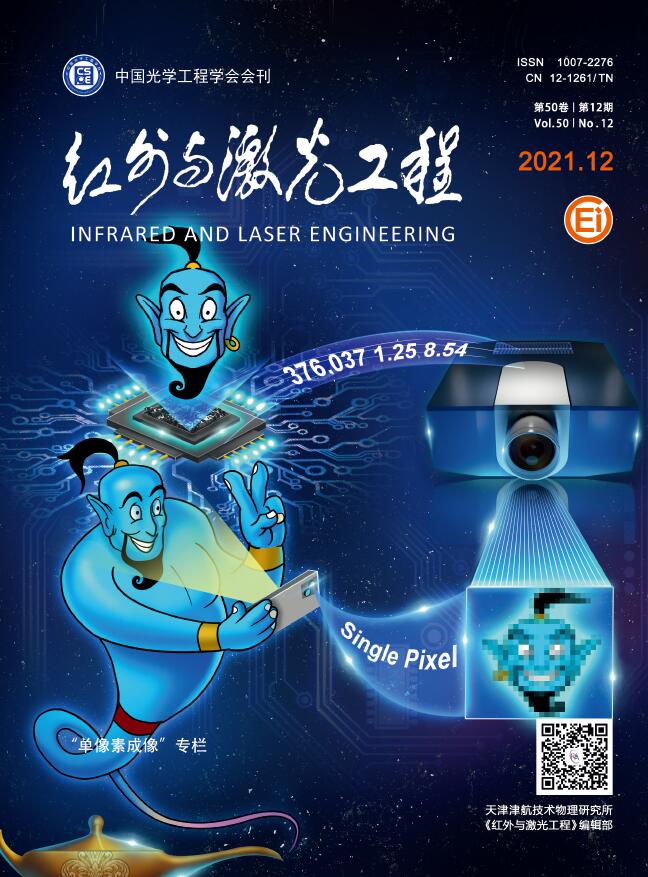


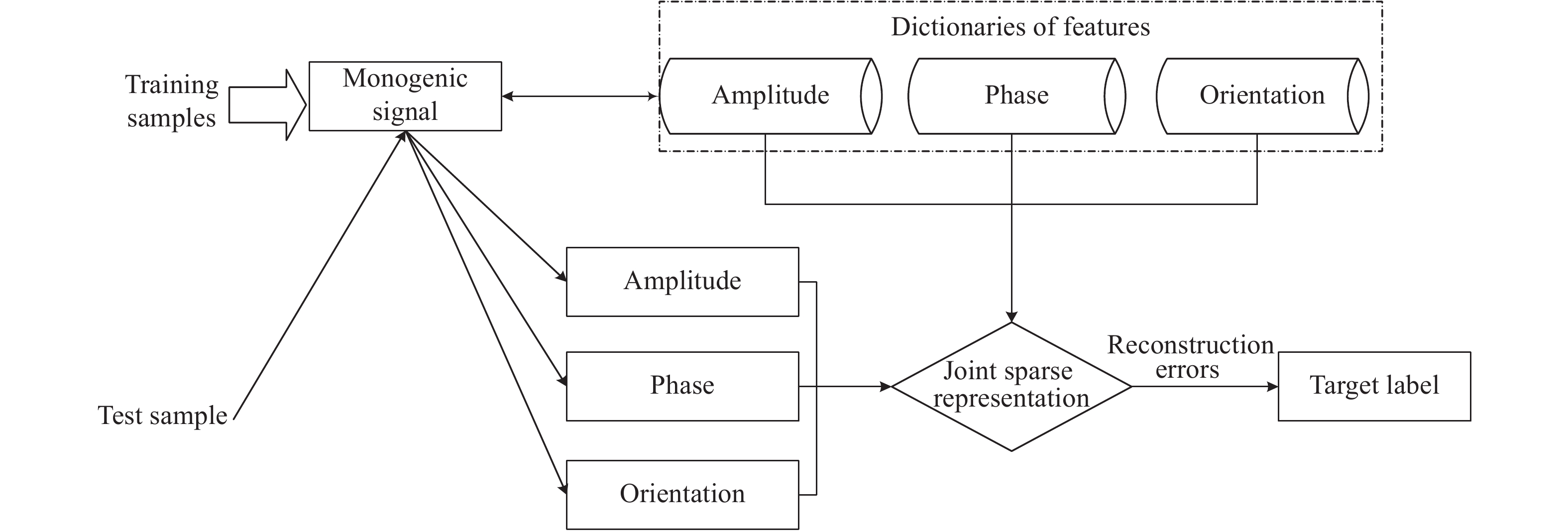





























 DownLoad:
DownLoad:

